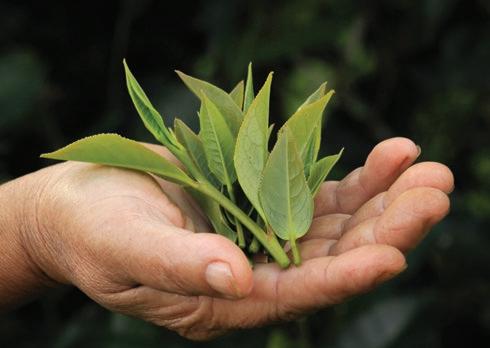
2 minute read
Defining Tea
D E F I N I N G T E A
Tea is harvested from a single plant species called Camellia sinensis. The tea plant is an evergreen tree originally native to the part of Southeast Asia where China’s Yunnan province meets India’s Nagaland region and the northern areas of Myanmar, Thailand, Laos and Vietnam. Today, tea is grown in over 50 countries spanning tropical and subtropical climates.
Advertisement
From this one species stems two main varieties known as assamica and sinensis, and a third lesser known variety called cambodiensis. The assamica or “broad leaf” variety most closely resembles the original tea plant, whereas the sinensis or “small leaf” variety evolved as the tea plant was carried from its subtropical homeland to more temperate climates. Under each of these varieties fall hundreds of sub-species known as cultivars (from “cultivated variety”). New cultivars are developed when tea farmers selectively breed tea plants that demonstrate preferred qualities such as a stellar aromatic complexity or the tenacity to thrive in periods of frost or drought. For us, understanding the cultivars of our teas is as essential as understanding a varietal of wine; each cultivar offers an archetype tannin structure, nutrient composition and flavor nuance based upon its unique genetics. Left in its natural state, Camellia sinensis grows into a tree that reaches about six feet tall for small leaf varieties, to over 50 feet tall for the ancient broad leaf trees of Southeast Asia. Cultivated tea gardens are managed by pruning tea trees into bushy hedges or rows, making it easier to pick young leaves that sprout up on top of the “plucking table.” To this day, most tea is picked by hand.
In the northern hemisphere, the harvest season begins in late February or March and runs through September or October. Throughout the growing season, tea plants sprout tender new buds in a series of growth surges called flushes. Most tea regions experience three or four distinct flushes within each crop year. During the winter months, the plants go dormant and their energy and nutrients are stored within the roots.
In the springtime, these nutrients are drawn up and become concentrated in the new growth. For this reason, the spring harvest or “first flush” is typically the most prized of the year. This is a bit of an oversimplification; the annual calendar of tea, and its associated phytochemistry, must be considered in the context of geography and terroir. As an example, the winter high mountain oolong harvest in Taiwan produces some of the most coveted teas in the world.
In the market, we have found that tea is most often compared with that other caffeinated botanical, coffee. In our practice, however, we cannot help but recognize the truer parallels between tea and wine. Coffee is often grown in regions without a history of local consumption. Tea, like wine, was traditionally consumed by the people who cultivated it. The culture of tea is inextricable from its origin. We hope the origin narratives laced throughout this Lookbook stoke your passion for understanding the rich stories behind Rishi’s tea and botanicals.











